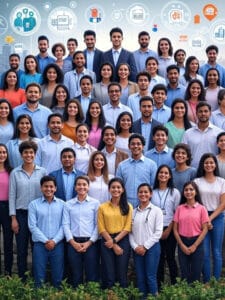The Great Human Engine
How India’s People Drive Its True Prosperity
If a nation’s soul is measured by its sovereign wealth and physical assets, then its beating heart — the true engine of prosperity — is undoubtedly its human capital. For India, this goes far beyond a demographic label; it is a vibrant, self-propelling force deeply rooted in social fabric, powered by unwavering family commitment.
Failure of human capital—like poor education, lack of skills, and eroded social cohesion—leads to the decay of societies by undermining productivity, innovation, and governance. Without a capable and motivated population, economies stagnate, inequality grows, and political institutions weaken. Historical examples include the decline of the Roman Empire, where reduced civic participation and loss of educated elites contributed to societal collapse. More recently, countries like Syria have seen social and economic breakdown due in part to loss of human capital amid conflict, resulting in enduring instability and hardship.
India’s Human Wealth
 At the center of India’s human wealth lies unparalleled and aspirational human capital, fundamentally nurtured by the Indian family unit. Unlike countries where the state increasingly shoulders child-rearing and education, India relies on a powerful, implicit social contract in which parents play the primary role in raising, disciplining, and educating their children. This cultural imperative compels parents to invest immense time, money, and emotional energy, fueling their children’s upward mobility. This dedication continuously feeds India’s talent pipeline, especially with over half of the country’s population under 25 years of age, forming a potent demographic dividend.
At the center of India’s human wealth lies unparalleled and aspirational human capital, fundamentally nurtured by the Indian family unit. Unlike countries where the state increasingly shoulders child-rearing and education, India relies on a powerful, implicit social contract in which parents play the primary role in raising, disciplining, and educating their children. This cultural imperative compels parents to invest immense time, money, and emotional energy, fueling their children’s upward mobility. This dedication continuously feeds India’s talent pipeline, especially with over half of the country’s population under 25 years of age, forming a potent demographic dividend.
This demographic vitality is reflected in the sheer scale of India’s STEM education machine: India produces over 1.5 million engineering graduates annually, a figure that rivals or surpasses the annual output of engineers and STEM graduates in many other countries combined. This enormous pool doesn’t just drive the domestic technology and manufacturing sectors, but also supplies talent to the globe, further exemplifying India’s indispensable role in the international STEM workforce.
The result is a thriving ecosystem of self-starters — doctors, chartered accountants, engineers, and professionals — who frequently create jobs rather than merely seeking employment. These entrepreneurial individuals build businesses that generate employment and economic activity from the ground up. Fueled by family values and individual grit, this decentralized dynamism is a cornerstone of India’s services sector and internal economy, less reliant on state-led or large corporate interventions.
Supporting these human capital strengths is India’s steady progress on the Human Development Index. Ranked 130th out of 193 countries in 2025, India’s HDI score has risen by over 53% since 1990, led by improvements in education (with an average expected schooling now near 13 years), life expectancy (72 years), and income per capita (over $9,000 PPP dollars in 2023).
Diaspora of India
On the global stage, India’s vast diaspora — over 32 million strong — spreads across countries, including 5 million non-resident Indians and 13.5 million persons of Indian origin. This diaspora, powered by the same values of aspiration and education, excels in fields from technology to healthcare worldwide. Their success translates into an immense economic boon for India: remittances exceeding $125 billion in 2023. These remittances are earned income, not aid or loans, furnishing crucial foreign exchange, stimulating consumption, and funding investments, all without the strings attached to traditional development aid.
Artificial Intelligence
Moreover, India is emerging as an artificial intelligence (AI) powerhouse, retaining roughly 20% of its AI researchers domestically and harnessing AI across sectors such as agriculture and healthcare to broaden inclusive growth opportunities. India is rapidly emerging as a global leader in Artificial Intelligence (AI) through its National AI Mission launched in 2024. The country focuses on expanding AI talent, enhancing data accessibility, and fostering cutting-edge research. India integrates AI in sectors like healthcare, agriculture, and education to drive inclusive growth. With investments surpassing ₹10,300 crore (~$1.25 billion) and the creation of world-class AI infrastructure, India supports startups and research institutes developing AI solutions tailored to local languages and needs. India’s the domestic AI market projected to reach around $7.8 billion in 2025 and expected to triple to $17 billion by 2027. India is home to 16% of the world’s AI talent, second only to the US, supported by a strong STEM education system and a thriving startup ecosystem of over 4,500 AI companies.
The Engine of Prosperity
In sum, India’s human capital is not just a demographic asset but a dynamic, self-sustaining engine of prosperity. Deeply embedded in family values, ambition, and entrepreneurship, it powers both the domestic economy and global financial inflows, representing a form of wealth no GDP metric can fully capture. This human engine remains the heart of India’s enduring growth and prosperity.
